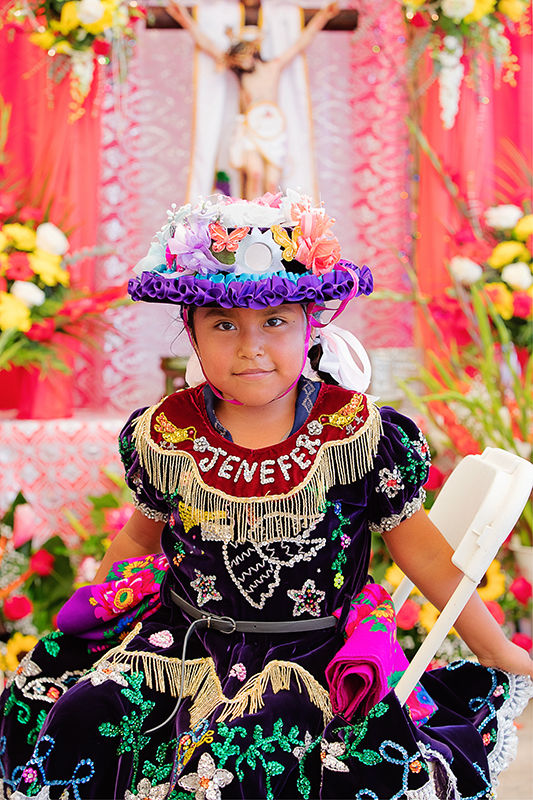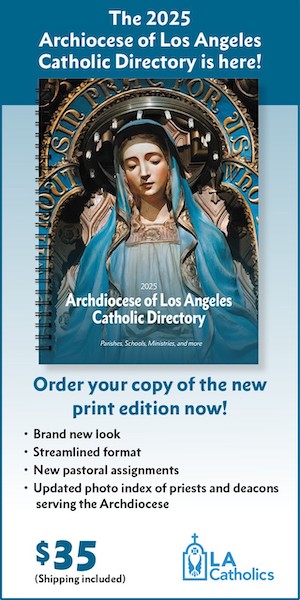“God’s mercy unites all people.”
Men, women and children representing the diverse races, cultures and languages that comprise the three-county Archdiocese of Los Angeles will gather at the Cathedral of Our Lady of the Angels at 10 a.m. on Sept. 17 to worship together under this unifying moniker, the theme of the 12th annual Mass of Cultures.
Archbishop José H. Gomez will concelebrate the upcoming Mass with special guest Archbishop Chamnian Santisukniran of Tharae-Nongsaeng, Thailand, several auxiliary bishops and more than 10 priests of various communities from across the L.A. Archdiocese.
Seven languages will be spoken during the liturgy and representatives of 45 ethnic groups are expected to participate, processing into the cathedral donning traditional attire or regalia native to their homelands. Many will also serve as ushers, altar servers or eucharistic ministers, or carry in altar cloths and the offertory gifts.
This year’s Mass of Cultures will also highlight two ethnic communities: Polish (Our Lady of the Bright Mount Church, Los Angeles) and Lithuanian (St. Casimir, Los Angeles). The introductory rite will feature Lithuanian girls carrying cultural religious symbols, followed by the image of Divine Mercy and a procession of children of Polish and Lithuanian heritage.
According to Marija S. Newsom, who is of Lithuanian descent and serves as liaison for the archdiocesan Office of Ethnic Ministries, the original Divine Mercy painting hangs in a church shrine in Vilnius, Lithuania, where “the Catholic faith and Lithuanian culture have always gone hand in hand” — as they have in her own life, despite having arrived in the U.S. as a refugee at just two weeks of age.
“My parents were ever grateful to be in a free country in which their three children became college-educated productive members of society. However, we always lived a bicultural life,” she recalled. “We spoke Lithuanian at home, we worshipped in our Lithuanian church, our first prayers were in our native language.
“As a matter of fact,” she added jokingly, “we thought God only understood Lithuanian! We … were taught to love our cultural roots and to remember the sufferings of our people left behind the Iron Curtain or exiled to Siberia.”
Newsom continued the bicultural tradition with her own three children, who are now adults. Together with her husband, they are longtime parishioners at St. Casimir — the only Lithuanian Catholic parish west of the Mississippi — where she has been the director of the parish’s Lithuanian Heritage School for 30 years, fostering religious education and sacramental preparation of parish children.
“We are so very blessed to have a parish in Los Angeles where we can pray and be culturally enriched. Our priests have been able to draw the faithful using both Lithuanian and English,” said Newsom of her parish, which is celebrating its 75th jubilee year. “We’re grateful to be part of the very rich, multicultural tapestry of the Archdiocese of Los Angeles, to which we add our own unique gifts.”
Paul Amuchie, of Igbo-Nigerian ethnicity, makes up part of that local tapestry of Catholic universality. He arrived in the U.S. from Nigeria in 1977 to attend graduate school at UCLA. He was 30 years old. He earned a Ph.D. in psychology, launched his career, married, had four (now grown) children and one grandchild.
Now a retiree, Amuchie devotes his free time to fostering both his culture and his Catholic faith by routinely taking part in the African National Eucharistic Congress, and being an active member at his parish, St. Eugene Church in Los Angeles, which boasts a membership of nearly 1,000 Igbo-Nigerian families.
“We come from a very strong culture,” explained Amuchie, a culture that adhered to a strong moral code — akin to the 10 commandments — long before the arrival of Irish missionaries who converted his people to Catholicism. That moral foundation was already in place before the introduction to Christianity, he noted.
“That’s why it was very easy for the Irish to convert us to Catholicism, because we already shared the same [morals and values] in our culture,” said Amuchie.
And they still do.
“It’s very important for us to celebrate our liturgy in our own culture, in our own language and also for our children to learn the culture through our religion,” he explained. “A sense of family, a sense of community are very important to us.”
Amuchie continued, “We go to church with our children, to help build a very strong Catholic community within the archdiocese.”
In addition to receiving the sacraments, children are encouraged to be engaged and actively involved in the parish, via youth groups and other parish ministries.
“Through [the combination] of our religion and culture, our children will also be able to learn what we learned while growing up [in Nigeria],” he stressed.
Miriam Lopez, who was born and raised in Oaxaca, Mexico, grew up with a similar — and similarly impactful — overlap between faith and culture.
Lopez said she feels connected to Catholicism, Marian celebrations and all Christian denominations at once through her diverse cultural upbringing in Oaxaca, which celebrated pre-Columbian customs, such as Day of the Dead, and Catholic celebrations, such as the feast of Our Lady of Guadalupe, with equal fervor.
“We lived these vibrant celebrations every year, without thought to their origins. They were all part of our shared cultural heritage,” she explained. “Half of my culture is enmeshed with religion. It would be impossible to separate the two.”
Even the dances have religious aspects woven into them, said Lopez. In all, the modern-day Oaxacan culture is a fusion of various Catholic and indigenous influences.
Lopez first visited the U.S. in 1992 as part of a traveling cultural dance troupe, returning to stay as a resident the following year. Today she continues teaching and performing Oaxacan regional dance in the L.A. area, where she attends St. Cecilia Church, which presents a Oaxacan-style Spanish-language Mass once a month.
“It all goes together seamlessly, and connects us to one another,” said Lopez.
For Surya Hartini, a native of Indonesia and parishioner at St. Stephen Martyr Church in Monterey Park, her Catholic faith not only bonded her to her Indonesian roots and her parish community, it also helped sustain her during a lengthy estrangement from her only child, a grown daughter named Eileen.
“After my husband left, she got influenced from the other side and she stopped talking to me, but I kept my faith and gave it up to God,” she recalled. “For almost 10 years, every time I went to church I prayed for her.”
And nearly every morning, Hartini would fax or email her daughter a different Scripture verse. “And I kept texting her,” she added, “but she never responded.”
But eventually, nearly a decade later, her prayers were answered. After nearly 10 years of silence, Hartini knew it was finally “time to reconcile,” she recounted through happy tears, her voice breaking.
“On her birthday I called her and she picked up the phone. We got together again and we went on a [multiweek] spiritual reflection together,” she said.
“After that,” she continued, “somehow, because of my faith and prayers, we went on a retreat together for eight days.”
The faith that had held her up all those years, interwoven into her Indonesian culture, also served as the glue to help mend their estrangement, she said.
“For me,” said Hartini, “that was a miracle.”

